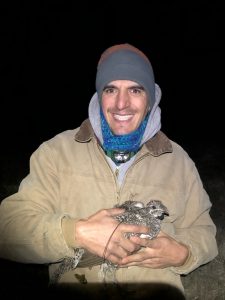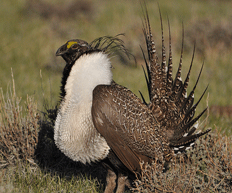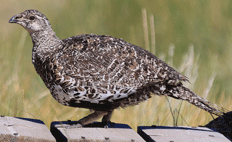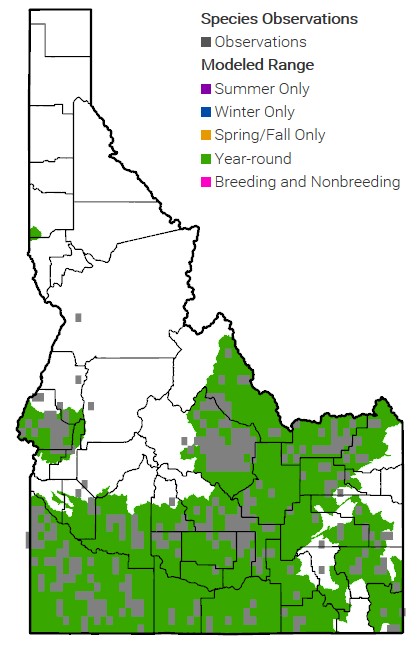ESA Status: Delisted and Removed from List
Greater sage-grouse (Centrocercus urophasianus) are found in 11 western states, including Idaho. First described by Lewis and Clark in 1804, sage-grouse are considered sagebrush obligates, meaning they depend on sagebrush for food and protection from predators. The bird is considered to be an “umbrella” species of the sage-steppe ecosystem. The sage-steppe ecosystem is also essential for more than 350 other sagebrush obligate species, including mule deer, elk, prong horn, and pygmy rabbits.In March 2010, the U.S. Fish and Wildlife Service (FWS) designated the greater sage-grouse as a candidate for listing under the Endangered Species Act (ESA). Concerns about long-term declines in sage-grouse populations and habitat prompted unprecedented large-scale efforts in Idaho and other western states to conserve the species while continuing predicable levels of land-use activities. In September 2015, the FWS determined that ongoing conservation efforts had significantly reduced threats to the point where sage-grouse was no longer warranted for protection under the ESA. Collaborative efforts from state and federal agencies, private landowners, and conservation groups are credited for the decision to not list the species.As part of the west-wide planning effort, the U.S. Bureau of Land Management (BLM) and U.S Forest Service (USFS) started a planning process to address the needs of the sage-grouse on federal lands through a range-wide land-use plan amendment process.
In March 2012, Governor Otter issued Executive Order 2012-02 establishing the Governor’s Sage-Grouse Task Force. This diverse group of stakeholders which included representatives from industry, sportsmen, conservation groups, and elected officials was charged with developing a state-wide conservation plan to preclude the need to list the species under the ESA. The group met eight times between March and May with each meeting open to the public. The Task Force delivered its recommendations to the Governor in June 2012, which were then rolled into an “Alternative” for incorporation into the federal land-use plan amendment process.
The Governor’s Alternative, which was published in September 2012, adopted the designation of a Sage-Grouse Management Area with three distinct management zones: Core Habitat (CHZ), Important Habitat (IHZ), and General Habitat (GHZ). This allows managers to provide a high level of protection to the best habitat, or the CHZ, and provide the most flexibility in the GHZ. The Governor’s Alternative builds on the 2006 Conservation Plan for the Greater Sage-Grouse in Idaho and focuses on the most urgent threats to the bird’s habitat, which is fragmentation due to fire and invasive species. The full version of the alternative can be read here (Federal Alternative of Governor C.L. “Butch” Otter for Greater Sage-Grouse Management in Idaho).
The plan was selected as a co-preferred alternative by the BLM and USFS in the Environmental Impact Statement (EIS) process for amending 88 Resource Management Plans in sage-grouse habitat. The Record of Decision and final plan for sage-grouse conservation on federal lands, which includes portions of the Governor’s Alternative, was released in September 2015. The final EIS can be read here (Idaho and Southwestern Montana Greater Sage-Grouse Final Environmental Impact Statement).
While the not-warranted determination for sage-grouse is the desired outcome for the state, in late 2014 federal agencies in Washington D.C. deviated from Idaho’s local, scientifically-based collaborative agreement and unilaterally adopted additional and unnecessary restrictions for land use activities in key sage-grouse habitat. After exhausting all administrative options, former Idaho Governor C.L. “Butch” Otter and the Idaho State Legislature filed a lawsuit over the BLM and USFS’s last minute adoption of overly restrictive land use plan amendments. The 2015 amendments violated the federal agencies’ mandate to manage public land for multiple-uses, which include recreation, resource development, fish and wildlife, and livestock grazing. This was done without proper analysis and vetting by the states or the public. The Governor contended the flawed amendment process by the BLM and USFS undermined years of open partnership-driven work by local and state leaders and other stakeholders. For more information about the lawsuit, read Governor Otter’s press release here: (Press release: Governor Otter, Legislature Sue Feds over Flawed Process behind Sage-Grouse).
The Governor’s Alternative became the “Idaho Plan” when it was signed into law by Executive Order 2015-04 providing an innovative strategy for dealing with the primary threats to the species in Idaho (wildfire, invasive species, habitat fragmentation, etc.) while maintaining predictable levels of land use.
In June 2017, Secretary of the Interior, Ryan Zinke, authorized Secretarial Order 3353 to enhance cooperation and support partnerships between the Department of the Interior and state entities in 11 western states for sage-grouse management and conservation on federal lands. The Department of the Interior and BLM worked collaboratively with western governors to amend the 2015 Sage-Grouse Amendments to better align with existing state plans and policy. The foundational elements of the Idaho Plan were used to craft the 2018 Greater Sage-Grouse Land Use Plan Amendment and Final Environmental Impact Statement through the dedication and collaboration between the State of Idaho, including OSC and key stakeholders. This plan was aimed to meet the needs of the greater sage-grouse while respecting Idaho’s economic vitality and its people’s way of life. This later resulted in the development of the2019 Greater Sage-Grouse Land Use Plan Amendments and Environmental Impact Statements. The 2019 Plan Amendments were enjoined by a judge and the BLM is currently operating under the 2015 Plan Amendments. OSC continues to work with its local, state and federal partners on a collaborative planning effort in the proper management of sage-grouse.
Collaborative efforts between 2017 and 2021 with the Bureau of Land Management (BLM) and the United States Forest Service (USFS) have resulted in signed agreements with the State of Idaho. The purpose of the Memorandum of Agreement between the State and the BLM is to enhance coordination across a greater landscape between the State and BLM Idaho relating to the management and protection of sage-grouse and its habitat. Similarly, the USFS signed a Memorandum of Understanding with the State to describe a framework for coordination between the State and USFS under whichever plans are currently in effect for management and protection of sage-grouse and its habitat.
The State of Idaho has formatted a new statewide plan for sage-grouse conservation to develop a management framework created with a diverse set of stakeholders. The Idaho 2021 Plan became law through Executive Order 2022-03, signed by Governor Brad Little on March 18th, 2022. This plan provides, in context of multiple-use management, Idaho-specific policy direction and recommendations for sage-grouse conservation and management on lands administered by the BLM and USFS, and for other actions with a federal nexus in Idaho’s sage-grouse management area (SGMA). Although not binding, the plan is recommended for private landowners to reference as well for their own management practices in concern to sage-grouse. The Idaho 2021 Plan contains a suite of policy and management measures to address primary threats and some secondary threats to sage-grouse.
Executive Order 2022-03 also included the Idaho Sage-Steppe Mitigation Principles, which offers core principles and standards for determining what effective mitigation is to help businesses, government entities, and individuals formulate their mitigation objectives associated with permits for infrastructure development in sage-grouse habitat in Idaho.
To complement the Governor’s Alternative for federal lands, the state completed a plan in April 2015 and updated it in October 2017 aimed at sage-grouse conservation on state endowment lands. This plan further demonstrates Idaho’s commitment to sage-grouse conservation and ensuring compliance with the State’s constitutional mandate to maximize revenue generation. For more information and to view the plan, see the following link:(Final IDL Greater Sage-Grouse Conservation Plan).
Governor Otter signed Executive Order 2015-04 on May 27, 2015, reinforcing Idaho’s greater sage-grouse conservation planning efforts. The executive order unites efforts to protect sage-grouse and its habitat across all land-ownerships to avoid a listing under the federal ESA, balanced with multiple use activities on public land.
The Natural Resources Conservation Service (NRCS) has been active in Idaho through the implementation of the Sage-grouse Initiative (SGI). The SGI works to sustain a healthy sagebrush steppe habitat through a partnership approach on private lands. The Office of Species Conservation works with private, state and federal land managers to complement the SGI through technical and financial assistance when implementing projects.
Learn more about SGI projects in Idaho:
Life on the Range – Beaver Dam Analogs, Catching on in Idaho
Sage Grouse Initiative – Low tech riparian restoration hits the ground in Idaho
See the Sage Grouse Actions Team tab under Planning.
In August 2015, the Soda Fire affected a large area of sagebrush steppe habitat in southwestern Idaho which included some Priority and Important habitat for sage-grouse. The Idaho Governor’s Office of Species Conservation (OSC) is dedicated to coordinating with federal, state, and local governments as well as private interests to implement conservation actions outlined within Governor Otter’s Sage-Grouse Conservation Plan. One of the main objectives of the plan is to implement actions aimed at ameliorating the primary threats to sage-grouse in Idaho; habitat fragmentation due to wildfires and invasive species.
In the aftermath of the Soda Fire, OSC staff began working alongside the Idaho Department of Fish and Game, Idaho Department of Lands, BLM, FWS, and private land owners to help prioritize and coordinate sage-grouse habitat restoration actions for state and private lands. Our collective goal with our partners is to ensure that habitat rehabilitation efforts and treatments are implemented seamlessly across the landscape to provide for a more consistent outcome. OSC has limited funding available for habitat rehabilitation efforts on state and private lands. OSC’s focus is to ensure that our rangelands remain healthy and viable for wildlife and predictable levels of land use activities.
To learn more about the Soda Fire rehabilitation efforts visit: Soda Fire Emergency Stabilization and Rehabilitation – Bureau of Land Management
Annually, Idaho Department of Fish and Game (IDFG) calculates two metrics to monitor sage-grouse population triggers within Priority Habitat Management Areas (PHMA) and Important Habitat Management Areas (IHMA) within the 4 Conservation Areas (CA). The metrics are maximum number of males on lek routes and lambda (λ), or the finite rate of population change, as calculated from all leks. Adaptive Management Populations Triggers are determined by the criteria described further within each report.
2015 Population Triggers Analysis Report
2016 Population Triggers Analysis Report
2017 Population Triggers Analysis Report
2018 Population Triggers Analysis Report
2019 Population Triggers Analysis Report
2020 Population Triggers Analysis Report
2021 Population Triggers Analysis Report
2022 Population Triggers Analysis Report
2023 Population Triggers Analysis Report
2024 Population Triggers Analysis Report
More Information:
Idaho Governor’s Greater Sage-Grouse Conservation Strategy
Sage-Grouse Conservation and Management – Idaho Department of Fish and Game
Sage Grouse Conservation Measures – Idaho Department of Lands
Staff Contact:



Aaron Malzlish on Flickr

Map Credit: Idaho Department of Fish and Game
 Official Government Website
Official Government Website